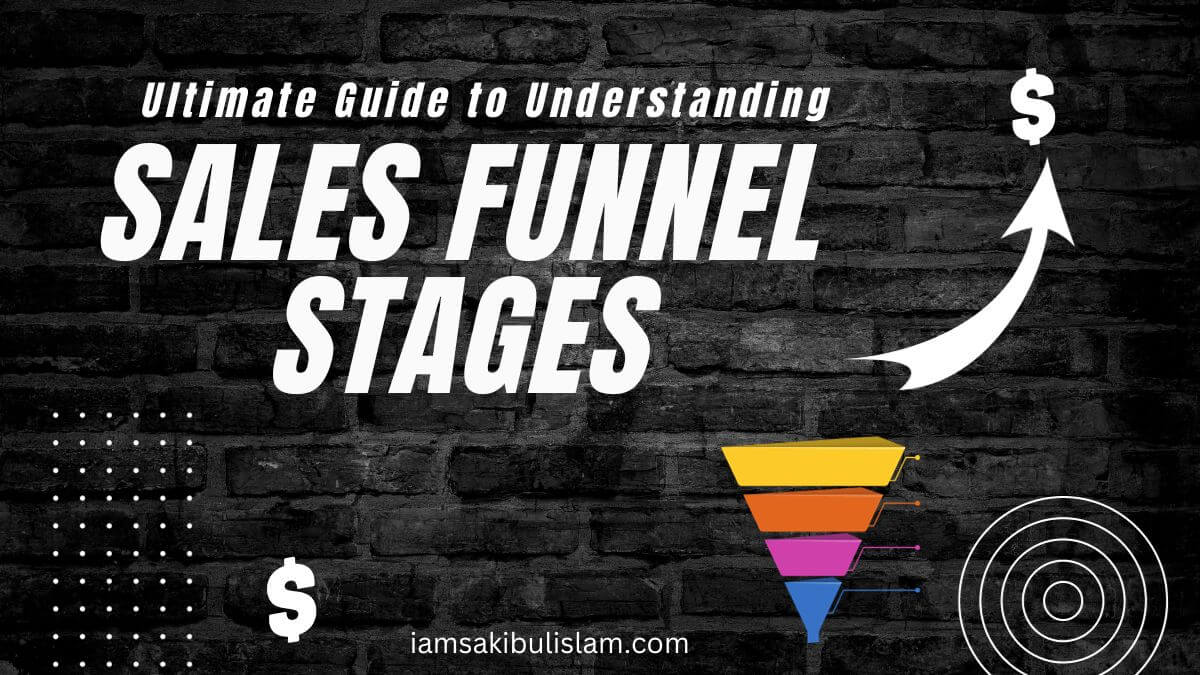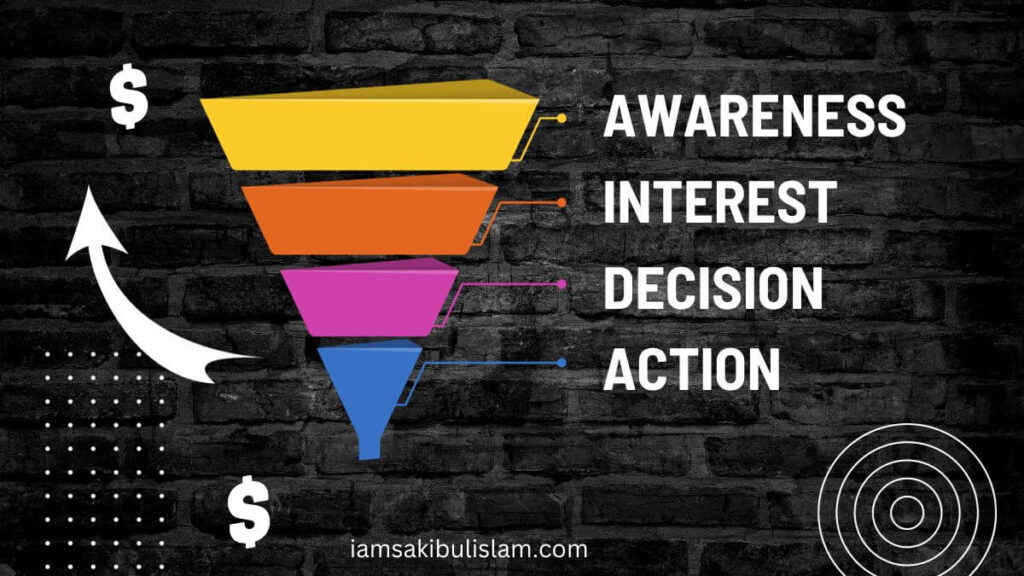The Ultimate Guide to Understanding Sales Funnel Stages

In the world of business, a sales funnel is a crucial tool that can help companies drive more leads, convert more customers, and increase their revenue. By breaking down the customer journey into different stages, businesses can identify areas for improvement in their sales process and create a more efficient and effective system. In this guide, we’ll provide you with a comprehensive overview of what a sales funnel is, why it’s important, sales funnel stages, and how to create one for your business.
- What is the Definition of a Sales Funnel?
- The sales funnel is essential for a number of reasons:
- Sales Funnel Stages
- Here's a Brief Description of The Different Stages Of A Typical Sales Funnel:
- How to Create A Best Sales Funnel for My Business?
- Deliver the right message to the right stage of your business sales funnel
- An Example of A Sales Funnel:
- Conclusion:
What is the Definition of a Sales Funnel?
A sales funnel is a visual representation of the customer journey, from initial awareness of a product or service to the eventual purchase. The funnel is made up of several stages, each of which represents a different point in the customer journey. The goal of the sales funnel is to guide customers through each stage of the process and ultimately convert them into paying customers. The sales funnel stages may vary depending on the business, but they generally include awareness, interest, consideration, intent, and purchase.
The sales funnel is essential for a number of reasons:
- Helps to understand the customer journey: The sales funnel provides a clear understanding of the different stages that customers go through before making a purchase. This knowledge helps businesses create a targeted marketing strategy that is relevant to each stage of the customer journey.
- Increases conversions: By identifying areas of improvement in the sales process, businesses can make changes that improve their conversion rates. This can result in more leads, more sales, and increased revenue.
- Improves customer experience: A well-designed sales funnel provides a seamless and personalized customer experience that can help build trust and loyalty. By understanding the needs and preferences of their customers, businesses can create a more enjoyable and satisfying shopping experience.
- Enables better tracking and analysis: With a sales funnel, businesses can track and analyze their customer’s journey through each stage. This data helps to identify bottlenecks in the sales process, measure the effectiveness of marketing campaigns, and make data-driven decisions to improve the sales process.
- Facilitates long-term customer relationships: By nurturing leads and building a relationship with their customers, businesses can increase the chances of repeat purchases and establish a loyal customer base. This can contribute to the company’s long-term success and growth.
Sales Funnel Stages
A sales funnel typically consists of several stages that represent the different steps that a customer goes through before making a purchase. Each stage of the funnel requires a different marketing strategy, and it is important for businesses to understand these stages to optimize their sales process.
Here’s a Brief Description of The Different Stages Of A Typical Sales Funnel:

Awareness Stage:
- This is the first sales funnel stages, where potential customers become aware of the business and its products or services. The focus of this stage is on creating brand awareness and attracting potential customers through various marketing channels.
Interest Stage:
- At this stage, the potential customer shows an interest in the business and its products or services. The goal is to capture the customer’s attention and encourage them to learn more about the business.
Consideration Stage:
- In this stage, the potential customer is actively considering whether or not to make a purchase. The focus of this stage is on providing information about the products or services and addressing any concerns or questions that the customer may have.
Intent Stage:
- At this stage, the customer has made the decision to make a purchase and is in the process of finalizing their decision. The focus of this stage is on providing incentives, such as free shipping or a discount, to encourage the customer to complete their purchase.
Purchase Stage:
- This is the final stage of the funnel, where the customer makes a purchase. The focus of this stage is on providing a seamless and enjoyable purchasing experience to encourage repeat business and positive reviews.
By understanding the different sales funnel stages, businesses can create a targeted marketing strategy that is relevant to each stage of the customer journey, leading to increased conversions and revenue.
How to build a nurture a sales funnel(intro, Analyse customers, Offer something of value, Identify the stages of your sales funnel, Create a great landing page, Create powerful campaign, Upsell, Keep following up)
How to Create A Best Sales Funnel for My Business?
Creating a successful sales funnel is an essential aspect of any business that wants to increase their revenue and grow their customer base. Here is a brief description of the steps involved in creating a best sales funnel for your business:
- Analysis customers: To build an effective sales funnel, you need to understand your target audience. Conduct market research to identify your ideal customer and their pain points, interests, and behavior.
- Offer something of value: To attract potential customers and build trust, offer something of value such as a free ebook, consultation, or webinar in exchange for their contact information.
- Identify the stages of your sales funnel: The stages of your sales funnel will depend on your business and marketing strategy. Identify each stage of the funnel and what actions a potential customer needs to take to move through each stage.
- Create a great landing page: A landing page is a standalone page designed to capture a potential customer’s information. Create a visually appealing and compelling landing page with a clear call to action to entice potential customers to take action.
- Create a powerful campaign: Develop a marketing campaign that targets potential customers at each stage of the funnel. Use targeted messaging, email marketing, social media advertising, and other tactics to nurture leads and move them through the funnel.
- Upsell: Once a customer has made a purchase, consider offering an upsell to increase revenue. For example, if a customer purchases a product, offer a related product or service that enhances their experience.
- Keep following up: Consistent follow-up is critical for nurturing a sales funnel. Continue to provide relevant content, answer questions, and offer additional value to keep customers engaged and loyal.
- Optimize your sales process: Continuously review and analyze your sales funnel to identify areas for improvement. Use data to optimize your marketing strategy, messaging, and sales process to increase conversions and revenue.
By following these steps, you can create a best sales funnel for your business that will help you to grow your customer base and increase your revenue.
Deliver the right message to the right stage of your business sales funnel
Delivering the right message to the right stage of the sales funnel is critical for effectively guiding potential customers through the buying journey. Here is a brief description of how to deliver the right message to the right stage of the sales funnel:
- Awareness stage: At the awareness stage, potential customers are just becoming familiar with your brand and are not yet ready to make a purchase. Your messaging should be focused on educating them about your product or service and building trust. Use content such as blog posts, social media posts, and infographics to educate potential customers and establish yourself as a thought leader in your industry.
- Interest stage: At the interest stage, potential customers have shown some interest in your product or service and are looking to learn more. Your messaging should focus on providing more detailed information about your product or service and how it can help solve their pain points. Use content such as case studies, white papers, and webinars to provide in-depth information and build trust.
- Consideration stage: At the consideration stage, potential customers are actively considering your product or service and are comparing it to competitors. Your messaging should focus on highlighting the unique benefits of your product or service and addressing any concerns or objections. Use content such as customer testimonials, comparison guides, and demos to provide detailed information and help potential customers make an informed decision.
- Purchase stage: At the purchase stage, potential customers have decided to buy your product or service. Your messaging should focus on making the buying process as easy and seamless as possible. Use content such as customer reviews, pricing information, and easy checkout processes to make the purchase process simple and efficient.
By delivering the right message to the right stage of the sales funnel, you can effectively guide potential customers through the buying journey and increase conversions.
An Example of A Sales Funnel:
Here is an example of a sales funnel for an online e-commerce store that sells fitness equipment:
Potential customers discover the e-commerce store through social media ads or search engine results. Potential customers click through to the e-commerce store and browse the products. They might read product descriptions and reviews, view images, and add items to their shopping cart. Potential customers may leave the e-commerce store without making a purchase. The e-commerce store uses email marketing to retarget these potential customers with special offers and promotions to encourage them to complete their purchase. Potential customers decide to make a purchase and complete the checkout process. The e-commerce store sends a confirmation email and offers a discount on their next purchase to encourage loyalty. The e-commerce store follows up with customers after their purchase to ensure their satisfaction and to offer additional products or services that complement their purchase.
This sales funnel illustrates how the e-commerce store is able to move potential customers through the buying journey from awareness to post-purchase follow-up. By using targeted marketing and email campaigns, the e-commerce store is able to nurture leads and increase conversions.
Conclusion:
In conclusion, a sales funnel is a powerful tool for guiding potential customers through the buying journey and increasing conversions. By understanding the sales funnel stages and creating targeted messaging and campaigns for each stage, businesses can effectively nurture leads and build strong relationships with customers. A well-constructed sales funnel is critical for the success of any business, whether it is a small e-commerce store or a large enterprise. By continually analyzing and refining your sales funnel, you can optimize your marketing efforts and achieve greater sales and revenue growth.


[…] guides you through every step, which eliminates the apprehension often associated with other sales funnel software. Considering what QuickFunnel brings to the table, you’ll find yourself saving a […]
[…] a cornerstone of modern digital marketing strategies, thrives when seamlessly integrated into a well-structured sales funnel. The synergy between email marketing platforms and a robust sales funnel is essential for driving […]